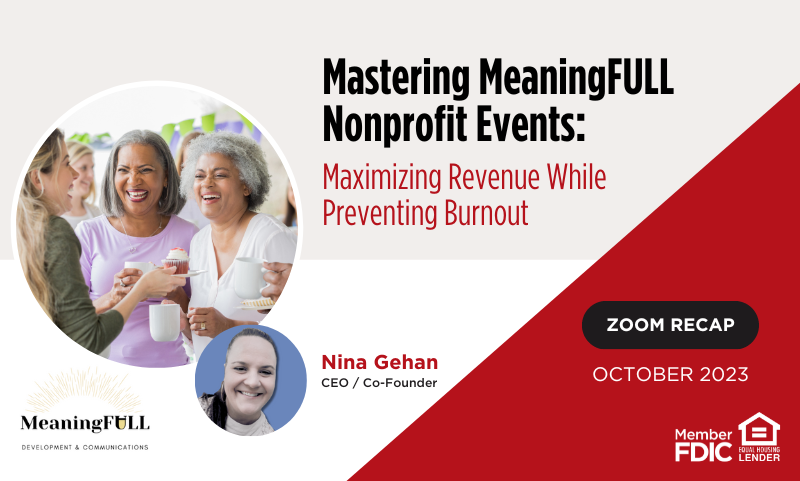How to Plan and Execute ‘MeaningFULL’ Nonprofit Events
Posted On: November 16, 2023 in: Nonprofit

The content in this article derives from Nina Gehan’s “Mastering MeaningFULL Nonprofit Events” webinar hosted by Park Bank in October of 2023. Gehan is the co-founder and CEO of MeaningFULL Development & Communications.
Breaking down the 5 stages of a successful fundraising event’s lifecycle
Fundraising events can be highly valuable to nonprofit organizations — if they’re executed properly.
Hosting an event presents a tremendous opportunity for nonprofits to connect with potential donors, raise funds, and spread their mission.
Of course, with limited resources, orchestrating an event that’s both financially successful and highly engaging can be a challenge.
How can you pull it off?
It starts by understanding the lifecycle of a successful fundraising event, according to MeaningFULL Development & Communications Co-Founder and CEO Nina Gehan.
A well-organized event involves 5 stages:
- Ideation/Pre-Planning
- Logistics and Coordination
- Marketing and Promotion
- Event Execution
- Event Follow-Up and Evaluation
Let’s break them down (timelines may vary based on size and scale of the event).
- Ideation/Pre-Planning: Approximately 12 months before event
“The first phase is to pre-plan, just thinking through the who, what, when, where, why, and how,” Gehan said.
Between you and your leadership team, you’ll need to answer several questions:
- Who is your audience?
- What type of event are you planning (e.g., concert, dinner)?
- When and where will your event take place?
- Why is your event taking place (e.g., your financial and engagement goals)?
- How will your event happen (e.g., what’s your event plan and who’s on your team)?
“In that pre-planning phase, try to decide how much money you need to make — think through your return on investment,” Gehan said.
- Logistics and Coordination: Approximately 7 months before event
Your event plan should address the following items:
- What’s your communication strategy?
- Who are your sponsors?
- What about event-day logistics such as food and beverage, decorations, volunteers, and technology?
- Have you considered your V.I.P. strategy?
- Will you have a silent auction, raffle, etc.?
“You can’t do it all on your own, so the biggest piece in planning is to segment your list,” Gehan said. “Start to think creatively about your networks, about your staff, about professional development. For example, who do you know that can do great marketing?”
Another critical step in this stage is sending out sponsorship requests.
“One thing I see a lot is that often sponsorship requests go out too late,” Gehan said. “If you can at least get an idea of what your event’s going to be and get those requests out early, you can start to build your revenue stream and go into your event feeling confident.”
- Marketing and Promotion: Approximately 3 months before event
Your invitations to potential donors should come in the marketing and promotion stage.
However, more than just sending an invitation may be necessary. Consider where donors hear about fundraising events and how you can best use their communication channels.
Data in Gehan’s presentation found that 50 percent of donors and stakeholders hear about events through a friend, family, or colleague. Twenty-eight percent were informed of the event directly by the nonprofit or charity, while 25 percent saw or heard an ad. Twenty percent heard through work, and 12 percent from an influencer or celebrity.
“You don’t just want to send an invite to the mayor,” Gehan said. “You need to find a way to reach that person personally and create a commitment on both ends, so that person actually shows up.”
- Event Execution: Day of event
Gehan offered a few event day tips.
“Cover your event — share photos, share videos,” Gehan said. “Make it an event that’s really meaningful and impactful, but where people can give easily and where systems are in place.”
You also must ensure volunteers clearly understand their duties. When assigning volunteers, try to put them in roles they’ll enjoy.
“Have different roles for people with different time commitments,” Gehan said. “I like to stress, consider what people like to do and tap into that.”
Here’s another piece of advice: Huddle up and make it enjoyable!
“Always have a huddle at the beginning of your event to get everyone on the same page,” Gehan said. “Make it fun. Order some lunch. What you need to do is really make it a team-bonding experience.”
“There are small things we can do to make people feel special.”
- Event Follow-Up and Evaluation: Approximately 1 month (plus) after the event
Your follow-up should take place within a month after your event. It involves thanking guests and volunteers.
After follow-up, you’ll evaluate the success of your event by running a SWOT analysis and calculating your ROI.
Gehan also recommends using her “S.M.I.L.E.” evaluation method.
- Sustainable: Can you replicate the event?
- Memorable: Was it exciting enough to remember?
- Impactful: Is the event mission-aligned and heart-focused?
- Likable: Do people enjoy the experience?
- Equitable: Does your guest list include guests from all different backgrounds?
“If you answered yes to all these questions, smile,” Gehan said. “Your event is meaningFULL.”
In addition to your SWOT, ROI, and S.M.I.L.E. evaluations, you should analyze your fundraising and engagement metrics and assess your gross versus net revenue.
“Did you have a lot of social media likes? Was it heavy in the press?” Gehan said. “Also, when reporting on your event, report in net dollars.”
Watch the full webinar:
